HRMT20024 Essay: Challenges in Attracting and Retaining Finance Staff
VerifiedAdded on 2022/11/15
|11
|3632
|345
Essay
AI Summary
This essay examines the significant challenges faced by companies in the finance sector regarding attracting and retaining employees. The financial industry, a major contributor to Australia's GDP and a significant employer, experiences high turnover rates, impacting the cost of managing human capital. The essay addresses key issues such as retaining millennial talent, fostering an attractive organizational culture, and addressing skills gaps. It explores various HR practices, including work design, HR planning (recruitment and selection), HR development, performance management, and talent retention strategies. The study highlights the importance of adapting to the changing work environment, incorporating technology, and aligning HRM strategies with organizational objectives to reduce employee turnover and improve overall business performance. The essay emphasizes the need for effective HR management to navigate financial uncertainties and successfully compete in the digital landscape. It also explores the importance of training, employee engagement, and creating a safe and healthy work environment.

Running Head: MANAGEMENT 0
MANAGING HUMAN
RESOURCES
MANAGING HUMAN
RESOURCES
Paraphrase This Document
Need a fresh take? Get an instant paraphrase of this document with our AI Paraphraser

MANAGEMENT 1
The key challenges in attracting and retaining a
workforce in Finance sector
The study aims to give brief information about the various significant challenges
faced by the companies in the finance sector in attracting and retaining individual. The
financial industry is known to be as one of the most diversified sectors which required
continuous employment of people from to manage organisation external business
environment. The rising turnover rate of Australian financial sector results in higher cost of
managing human capital and therefore, also impact negatively to the development of
Australian financial industry. Australian financial sector contributes a massive contribution to
GDP and therefore, plays an important role in reinforcing the domestic economic structure.
Considering the latest records by the government, financial sector of Australia contributes
$140 billion to GDP ranking the industry the largest in Australia in 2018
(fintech.treasury.gov.au, 2018). In addition, Australian finance sector been a major driver of
economic development employ more than 450,000 people all over the country.
Even with so much development and growth, the sector has faced various member
turnover challenges considering last several years. Many corporations found challenges in
fostering good working relationship with the next wave of disruption in the finance sector.
Due to this, not only will financial corporations requires expressively more and more
technology expertise referring to the future perspective, they will also need effective HR
managers and practices that can help in managing the change efficiency. Indeed, attracting
and retaining the competent workforce is also necessary for successfully competing and
innovating in this increasingly digital environment. Some of the key challenges faced by
finance industry and organisations includes retaining millennial talent, creating an attractive
organisation culture and the skills gap. This research is intended to hold with identifying key
issues in attracting and holding personnel in financial industry. It also explores various roles
and responsibilities of HR executives and its associated practices to avoid the issue of
employee turnover in relation with Australian financial industry. The complete study is based
on key five themes including work design challenges in an international environment, HR
planning in a varying environment, the context of Human Resource Management,
management of performance and talent retention and development.
The key challenges in attracting and retaining a
workforce in Finance sector
The study aims to give brief information about the various significant challenges
faced by the companies in the finance sector in attracting and retaining individual. The
financial industry is known to be as one of the most diversified sectors which required
continuous employment of people from to manage organisation external business
environment. The rising turnover rate of Australian financial sector results in higher cost of
managing human capital and therefore, also impact negatively to the development of
Australian financial industry. Australian financial sector contributes a massive contribution to
GDP and therefore, plays an important role in reinforcing the domestic economic structure.
Considering the latest records by the government, financial sector of Australia contributes
$140 billion to GDP ranking the industry the largest in Australia in 2018
(fintech.treasury.gov.au, 2018). In addition, Australian finance sector been a major driver of
economic development employ more than 450,000 people all over the country.
Even with so much development and growth, the sector has faced various member
turnover challenges considering last several years. Many corporations found challenges in
fostering good working relationship with the next wave of disruption in the finance sector.
Due to this, not only will financial corporations requires expressively more and more
technology expertise referring to the future perspective, they will also need effective HR
managers and practices that can help in managing the change efficiency. Indeed, attracting
and retaining the competent workforce is also necessary for successfully competing and
innovating in this increasingly digital environment. Some of the key challenges faced by
finance industry and organisations includes retaining millennial talent, creating an attractive
organisation culture and the skills gap. This research is intended to hold with identifying key
issues in attracting and holding personnel in financial industry. It also explores various roles
and responsibilities of HR executives and its associated practices to avoid the issue of
employee turnover in relation with Australian financial industry. The complete study is based
on key five themes including work design challenges in an international environment, HR
planning in a varying environment, the context of Human Resource Management,
management of performance and talent retention and development.
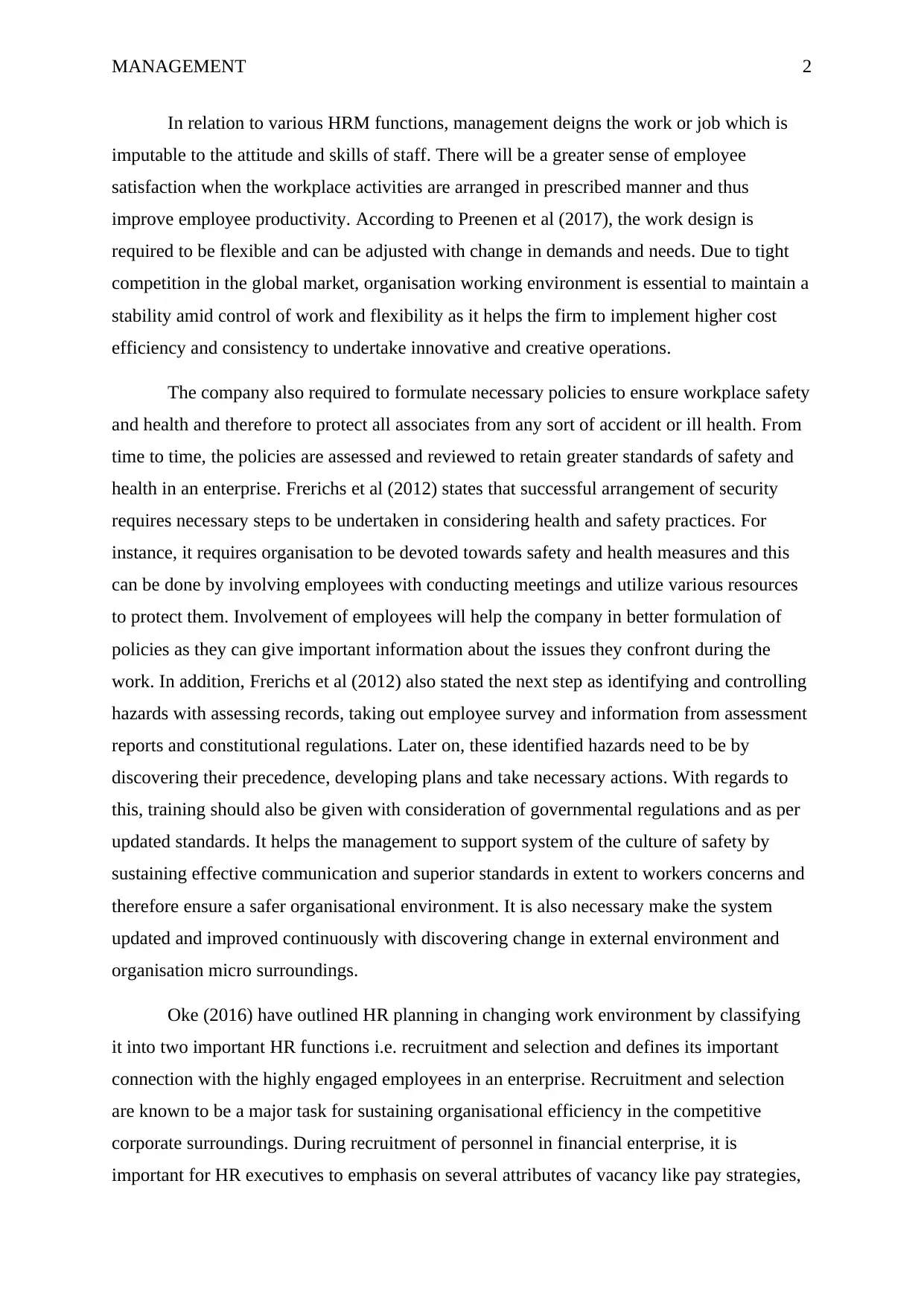
MANAGEMENT 2
In relation to various HRM functions, management deigns the work or job which is
imputable to the attitude and skills of staff. There will be a greater sense of employee
satisfaction when the workplace activities are arranged in prescribed manner and thus
improve employee productivity. According to Preenen et al (2017), the work design is
required to be flexible and can be adjusted with change in demands and needs. Due to tight
competition in the global market, organisation working environment is essential to maintain a
stability amid control of work and flexibility as it helps the firm to implement higher cost
efficiency and consistency to undertake innovative and creative operations.
The company also required to formulate necessary policies to ensure workplace safety
and health and therefore to protect all associates from any sort of accident or ill health. From
time to time, the policies are assessed and reviewed to retain greater standards of safety and
health in an enterprise. Frerichs et al (2012) states that successful arrangement of security
requires necessary steps to be undertaken in considering health and safety practices. For
instance, it requires organisation to be devoted towards safety and health measures and this
can be done by involving employees with conducting meetings and utilize various resources
to protect them. Involvement of employees will help the company in better formulation of
policies as they can give important information about the issues they confront during the
work. In addition, Frerichs et al (2012) also stated the next step as identifying and controlling
hazards with assessing records, taking out employee survey and information from assessment
reports and constitutional regulations. Later on, these identified hazards need to be by
discovering their precedence, developing plans and take necessary actions. With regards to
this, training should also be given with consideration of governmental regulations and as per
updated standards. It helps the management to support system of the culture of safety by
sustaining effective communication and superior standards in extent to workers concerns and
therefore ensure a safer organisational environment. It is also necessary make the system
updated and improved continuously with discovering change in external environment and
organisation micro surroundings.
Oke (2016) have outlined HR planning in changing work environment by classifying
it into two important HR functions i.e. recruitment and selection and defines its important
connection with the highly engaged employees in an enterprise. Recruitment and selection
are known to be a major task for sustaining organisational efficiency in the competitive
corporate surroundings. During recruitment of personnel in financial enterprise, it is
important for HR executives to emphasis on several attributes of vacancy like pay strategies,
In relation to various HRM functions, management deigns the work or job which is
imputable to the attitude and skills of staff. There will be a greater sense of employee
satisfaction when the workplace activities are arranged in prescribed manner and thus
improve employee productivity. According to Preenen et al (2017), the work design is
required to be flexible and can be adjusted with change in demands and needs. Due to tight
competition in the global market, organisation working environment is essential to maintain a
stability amid control of work and flexibility as it helps the firm to implement higher cost
efficiency and consistency to undertake innovative and creative operations.
The company also required to formulate necessary policies to ensure workplace safety
and health and therefore to protect all associates from any sort of accident or ill health. From
time to time, the policies are assessed and reviewed to retain greater standards of safety and
health in an enterprise. Frerichs et al (2012) states that successful arrangement of security
requires necessary steps to be undertaken in considering health and safety practices. For
instance, it requires organisation to be devoted towards safety and health measures and this
can be done by involving employees with conducting meetings and utilize various resources
to protect them. Involvement of employees will help the company in better formulation of
policies as they can give important information about the issues they confront during the
work. In addition, Frerichs et al (2012) also stated the next step as identifying and controlling
hazards with assessing records, taking out employee survey and information from assessment
reports and constitutional regulations. Later on, these identified hazards need to be by
discovering their precedence, developing plans and take necessary actions. With regards to
this, training should also be given with consideration of governmental regulations and as per
updated standards. It helps the management to support system of the culture of safety by
sustaining effective communication and superior standards in extent to workers concerns and
therefore ensure a safer organisational environment. It is also necessary make the system
updated and improved continuously with discovering change in external environment and
organisation micro surroundings.
Oke (2016) have outlined HR planning in changing work environment by classifying
it into two important HR functions i.e. recruitment and selection and defines its important
connection with the highly engaged employees in an enterprise. Recruitment and selection
are known to be a major task for sustaining organisational efficiency in the competitive
corporate surroundings. During recruitment of personnel in financial enterprise, it is
important for HR executives to emphasis on several attributes of vacancy like pay strategies,
⊘ This is a preview!⊘
Do you want full access?
Subscribe today to unlock all pages.

Trusted by 1+ million students worldwide
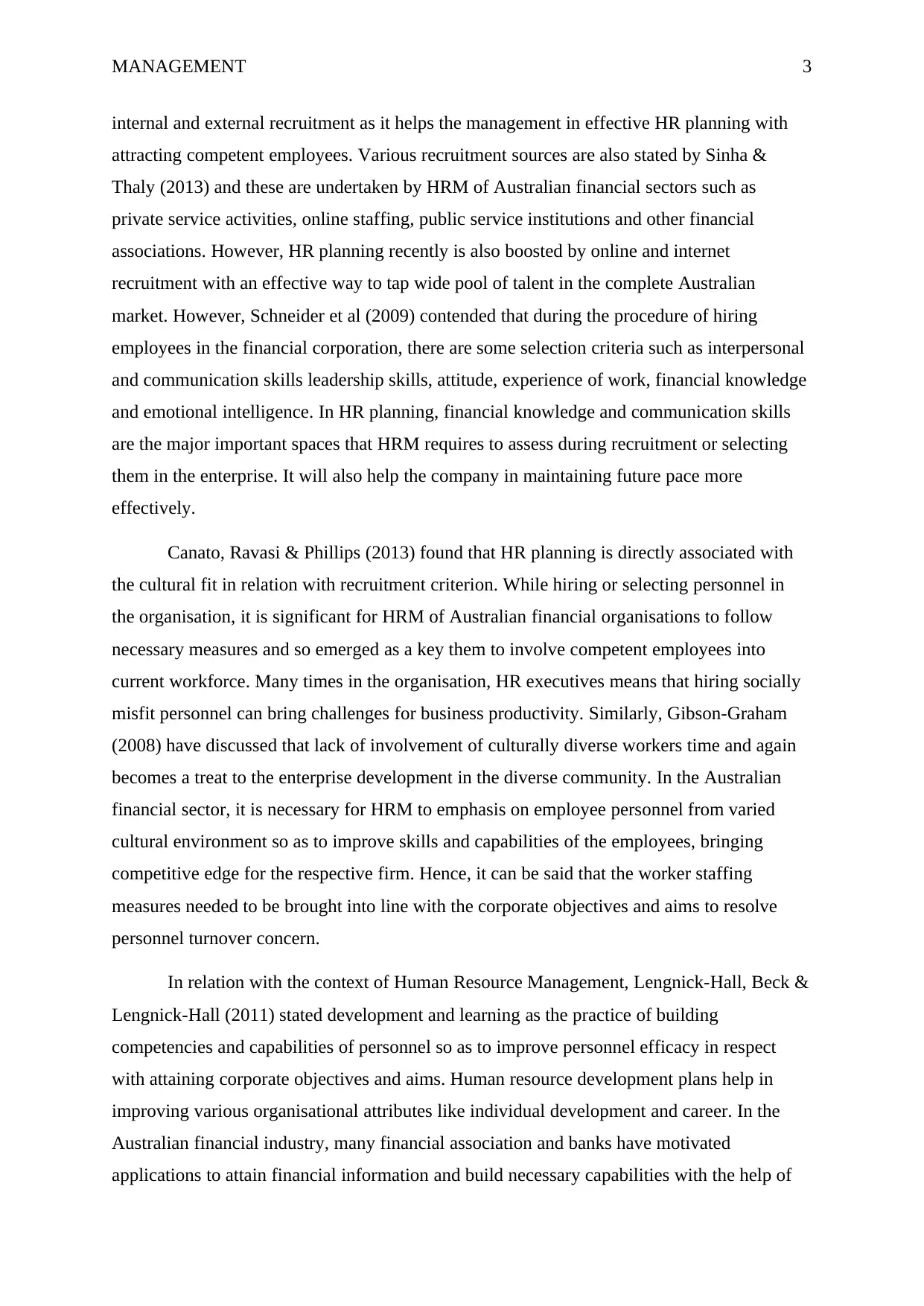
MANAGEMENT 3
internal and external recruitment as it helps the management in effective HR planning with
attracting competent employees. Various recruitment sources are also stated by Sinha &
Thaly (2013) and these are undertaken by HRM of Australian financial sectors such as
private service activities, online staffing, public service institutions and other financial
associations. However, HR planning recently is also boosted by online and internet
recruitment with an effective way to tap wide pool of talent in the complete Australian
market. However, Schneider et al (2009) contended that during the procedure of hiring
employees in the financial corporation, there are some selection criteria such as interpersonal
and communication skills leadership skills, attitude, experience of work, financial knowledge
and emotional intelligence. In HR planning, financial knowledge and communication skills
are the major important spaces that HRM requires to assess during recruitment or selecting
them in the enterprise. It will also help the company in maintaining future pace more
effectively.
Canato, Ravasi & Phillips (2013) found that HR planning is directly associated with
the cultural fit in relation with recruitment criterion. While hiring or selecting personnel in
the organisation, it is significant for HRM of Australian financial organisations to follow
necessary measures and so emerged as a key them to involve competent employees into
current workforce. Many times in the organisation, HR executives means that hiring socially
misfit personnel can bring challenges for business productivity. Similarly, Gibson-Graham
(2008) have discussed that lack of involvement of culturally diverse workers time and again
becomes a treat to the enterprise development in the diverse community. In the Australian
financial sector, it is necessary for HRM to emphasis on employee personnel from varied
cultural environment so as to improve skills and capabilities of the employees, bringing
competitive edge for the respective firm. Hence, it can be said that the worker staffing
measures needed to be brought into line with the corporate objectives and aims to resolve
personnel turnover concern.
In relation with the context of Human Resource Management, Lengnick-Hall, Beck &
Lengnick-Hall (2011) stated development and learning as the practice of building
competencies and capabilities of personnel so as to improve personnel efficacy in respect
with attaining corporate objectives and aims. Human resource development plans help in
improving various organisational attributes like individual development and career. In the
Australian financial industry, many financial association and banks have motivated
applications to attain financial information and build necessary capabilities with the help of
internal and external recruitment as it helps the management in effective HR planning with
attracting competent employees. Various recruitment sources are also stated by Sinha &
Thaly (2013) and these are undertaken by HRM of Australian financial sectors such as
private service activities, online staffing, public service institutions and other financial
associations. However, HR planning recently is also boosted by online and internet
recruitment with an effective way to tap wide pool of talent in the complete Australian
market. However, Schneider et al (2009) contended that during the procedure of hiring
employees in the financial corporation, there are some selection criteria such as interpersonal
and communication skills leadership skills, attitude, experience of work, financial knowledge
and emotional intelligence. In HR planning, financial knowledge and communication skills
are the major important spaces that HRM requires to assess during recruitment or selecting
them in the enterprise. It will also help the company in maintaining future pace more
effectively.
Canato, Ravasi & Phillips (2013) found that HR planning is directly associated with
the cultural fit in relation with recruitment criterion. While hiring or selecting personnel in
the organisation, it is significant for HRM of Australian financial organisations to follow
necessary measures and so emerged as a key them to involve competent employees into
current workforce. Many times in the organisation, HR executives means that hiring socially
misfit personnel can bring challenges for business productivity. Similarly, Gibson-Graham
(2008) have discussed that lack of involvement of culturally diverse workers time and again
becomes a treat to the enterprise development in the diverse community. In the Australian
financial sector, it is necessary for HRM to emphasis on employee personnel from varied
cultural environment so as to improve skills and capabilities of the employees, bringing
competitive edge for the respective firm. Hence, it can be said that the worker staffing
measures needed to be brought into line with the corporate objectives and aims to resolve
personnel turnover concern.
In relation with the context of Human Resource Management, Lengnick-Hall, Beck &
Lengnick-Hall (2011) stated development and learning as the practice of building
competencies and capabilities of personnel so as to improve personnel efficacy in respect
with attaining corporate objectives and aims. Human resource development plans help in
improving various organisational attributes like individual development and career. In the
Australian financial industry, many financial association and banks have motivated
applications to attain financial information and build necessary capabilities with the help of
Paraphrase This Document
Need a fresh take? Get an instant paraphrase of this document with our AI Paraphraser
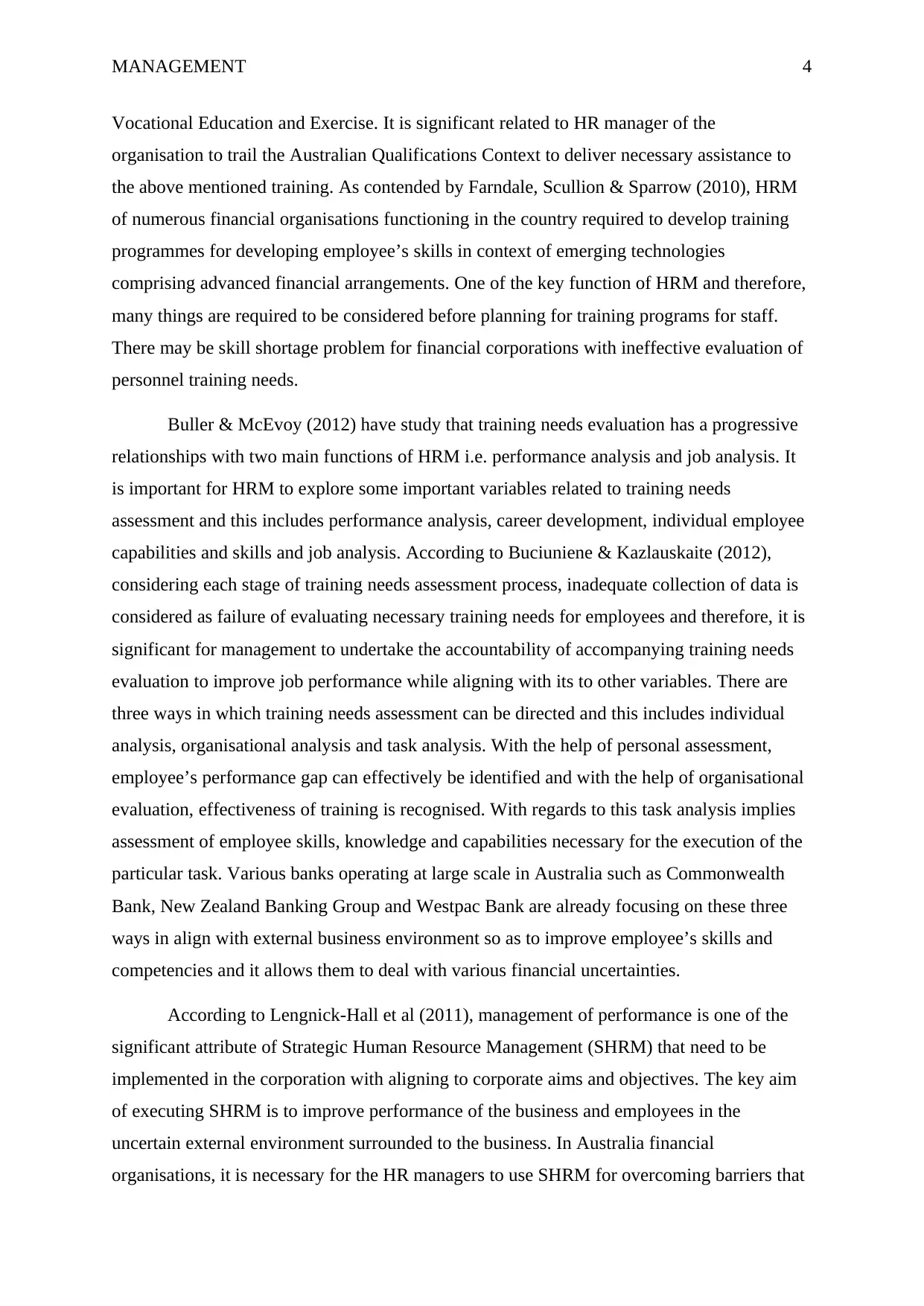
MANAGEMENT 4
Vocational Education and Exercise. It is significant related to HR manager of the
organisation to trail the Australian Qualifications Context to deliver necessary assistance to
the above mentioned training. As contended by Farndale, Scullion & Sparrow (2010), HRM
of numerous financial organisations functioning in the country required to develop training
programmes for developing employee’s skills in context of emerging technologies
comprising advanced financial arrangements. One of the key function of HRM and therefore,
many things are required to be considered before planning for training programs for staff.
There may be skill shortage problem for financial corporations with ineffective evaluation of
personnel training needs.
Buller & McEvoy (2012) have study that training needs evaluation has a progressive
relationships with two main functions of HRM i.e. performance analysis and job analysis. It
is important for HRM to explore some important variables related to training needs
assessment and this includes performance analysis, career development, individual employee
capabilities and skills and job analysis. According to Buciuniene & Kazlauskaite (2012),
considering each stage of training needs assessment process, inadequate collection of data is
considered as failure of evaluating necessary training needs for employees and therefore, it is
significant for management to undertake the accountability of accompanying training needs
evaluation to improve job performance while aligning with its to other variables. There are
three ways in which training needs assessment can be directed and this includes individual
analysis, organisational analysis and task analysis. With the help of personal assessment,
employee’s performance gap can effectively be identified and with the help of organisational
evaluation, effectiveness of training is recognised. With regards to this task analysis implies
assessment of employee skills, knowledge and capabilities necessary for the execution of the
particular task. Various banks operating at large scale in Australia such as Commonwealth
Bank, New Zealand Banking Group and Westpac Bank are already focusing on these three
ways in align with external business environment so as to improve employee’s skills and
competencies and it allows them to deal with various financial uncertainties.
According to Lengnick-Hall et al (2011), management of performance is one of the
significant attribute of Strategic Human Resource Management (SHRM) that need to be
implemented in the corporation with aligning to corporate aims and objectives. The key aim
of executing SHRM is to improve performance of the business and employees in the
uncertain external environment surrounded to the business. In Australia financial
organisations, it is necessary for the HR managers to use SHRM for overcoming barriers that
Vocational Education and Exercise. It is significant related to HR manager of the
organisation to trail the Australian Qualifications Context to deliver necessary assistance to
the above mentioned training. As contended by Farndale, Scullion & Sparrow (2010), HRM
of numerous financial organisations functioning in the country required to develop training
programmes for developing employee’s skills in context of emerging technologies
comprising advanced financial arrangements. One of the key function of HRM and therefore,
many things are required to be considered before planning for training programs for staff.
There may be skill shortage problem for financial corporations with ineffective evaluation of
personnel training needs.
Buller & McEvoy (2012) have study that training needs evaluation has a progressive
relationships with two main functions of HRM i.e. performance analysis and job analysis. It
is important for HRM to explore some important variables related to training needs
assessment and this includes performance analysis, career development, individual employee
capabilities and skills and job analysis. According to Buciuniene & Kazlauskaite (2012),
considering each stage of training needs assessment process, inadequate collection of data is
considered as failure of evaluating necessary training needs for employees and therefore, it is
significant for management to undertake the accountability of accompanying training needs
evaluation to improve job performance while aligning with its to other variables. There are
three ways in which training needs assessment can be directed and this includes individual
analysis, organisational analysis and task analysis. With the help of personal assessment,
employee’s performance gap can effectively be identified and with the help of organisational
evaluation, effectiveness of training is recognised. With regards to this task analysis implies
assessment of employee skills, knowledge and capabilities necessary for the execution of the
particular task. Various banks operating at large scale in Australia such as Commonwealth
Bank, New Zealand Banking Group and Westpac Bank are already focusing on these three
ways in align with external business environment so as to improve employee’s skills and
competencies and it allows them to deal with various financial uncertainties.
According to Lengnick-Hall et al (2011), management of performance is one of the
significant attribute of Strategic Human Resource Management (SHRM) that need to be
implemented in the corporation with aligning to corporate aims and objectives. The key aim
of executing SHRM is to improve performance of the business and employees in the
uncertain external environment surrounded to the business. In Australia financial
organisations, it is necessary for the HR managers to use SHRM for overcoming barriers that
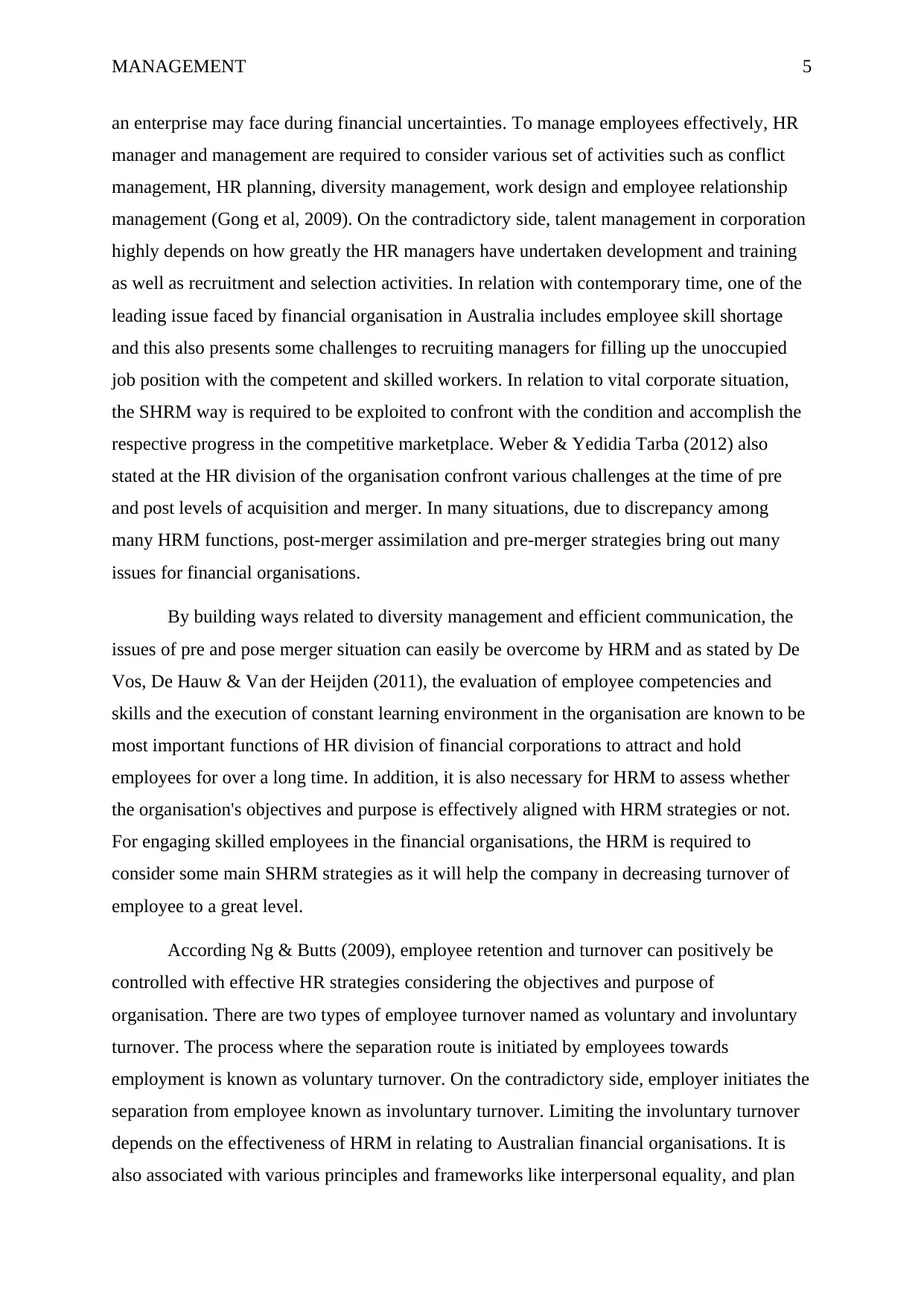
MANAGEMENT 5
an enterprise may face during financial uncertainties. To manage employees effectively, HR
manager and management are required to consider various set of activities such as conflict
management, HR planning, diversity management, work design and employee relationship
management (Gong et al, 2009). On the contradictory side, talent management in corporation
highly depends on how greatly the HR managers have undertaken development and training
as well as recruitment and selection activities. In relation with contemporary time, one of the
leading issue faced by financial organisation in Australia includes employee skill shortage
and this also presents some challenges to recruiting managers for filling up the unoccupied
job position with the competent and skilled workers. In relation to vital corporate situation,
the SHRM way is required to be exploited to confront with the condition and accomplish the
respective progress in the competitive marketplace. Weber & Yedidia Tarba (2012) also
stated at the HR division of the organisation confront various challenges at the time of pre
and post levels of acquisition and merger. In many situations, due to discrepancy among
many HRM functions, post-merger assimilation and pre-merger strategies bring out many
issues for financial organisations.
By building ways related to diversity management and efficient communication, the
issues of pre and pose merger situation can easily be overcome by HRM and as stated by De
Vos, De Hauw & Van der Heijden (2011), the evaluation of employee competencies and
skills and the execution of constant learning environment in the organisation are known to be
most important functions of HR division of financial corporations to attract and hold
employees for over a long time. In addition, it is also necessary for HRM to assess whether
the organisation's objectives and purpose is effectively aligned with HRM strategies or not.
For engaging skilled employees in the financial organisations, the HRM is required to
consider some main SHRM strategies as it will help the company in decreasing turnover of
employee to a great level.
According Ng & Butts (2009), employee retention and turnover can positively be
controlled with effective HR strategies considering the objectives and purpose of
organisation. There are two types of employee turnover named as voluntary and involuntary
turnover. The process where the separation route is initiated by employees towards
employment is known as voluntary turnover. On the contradictory side, employer initiates the
separation from employee known as involuntary turnover. Limiting the involuntary turnover
depends on the effectiveness of HRM in relating to Australian financial organisations. It is
also associated with various principles and frameworks like interpersonal equality, and plan
an enterprise may face during financial uncertainties. To manage employees effectively, HR
manager and management are required to consider various set of activities such as conflict
management, HR planning, diversity management, work design and employee relationship
management (Gong et al, 2009). On the contradictory side, talent management in corporation
highly depends on how greatly the HR managers have undertaken development and training
as well as recruitment and selection activities. In relation with contemporary time, one of the
leading issue faced by financial organisation in Australia includes employee skill shortage
and this also presents some challenges to recruiting managers for filling up the unoccupied
job position with the competent and skilled workers. In relation to vital corporate situation,
the SHRM way is required to be exploited to confront with the condition and accomplish the
respective progress in the competitive marketplace. Weber & Yedidia Tarba (2012) also
stated at the HR division of the organisation confront various challenges at the time of pre
and post levels of acquisition and merger. In many situations, due to discrepancy among
many HRM functions, post-merger assimilation and pre-merger strategies bring out many
issues for financial organisations.
By building ways related to diversity management and efficient communication, the
issues of pre and pose merger situation can easily be overcome by HRM and as stated by De
Vos, De Hauw & Van der Heijden (2011), the evaluation of employee competencies and
skills and the execution of constant learning environment in the organisation are known to be
most important functions of HR division of financial corporations to attract and hold
employees for over a long time. In addition, it is also necessary for HRM to assess whether
the organisation's objectives and purpose is effectively aligned with HRM strategies or not.
For engaging skilled employees in the financial organisations, the HRM is required to
consider some main SHRM strategies as it will help the company in decreasing turnover of
employee to a great level.
According Ng & Butts (2009), employee retention and turnover can positively be
controlled with effective HR strategies considering the objectives and purpose of
organisation. There are two types of employee turnover named as voluntary and involuntary
turnover. The process where the separation route is initiated by employees towards
employment is known as voluntary turnover. On the contradictory side, employer initiates the
separation from employee known as involuntary turnover. Limiting the involuntary turnover
depends on the effectiveness of HRM in relating to Australian financial organisations. It is
also associated with various principles and frameworks like interpersonal equality, and plan
⊘ This is a preview!⊘
Do you want full access?
Subscribe today to unlock all pages.

Trusted by 1+ million students worldwide
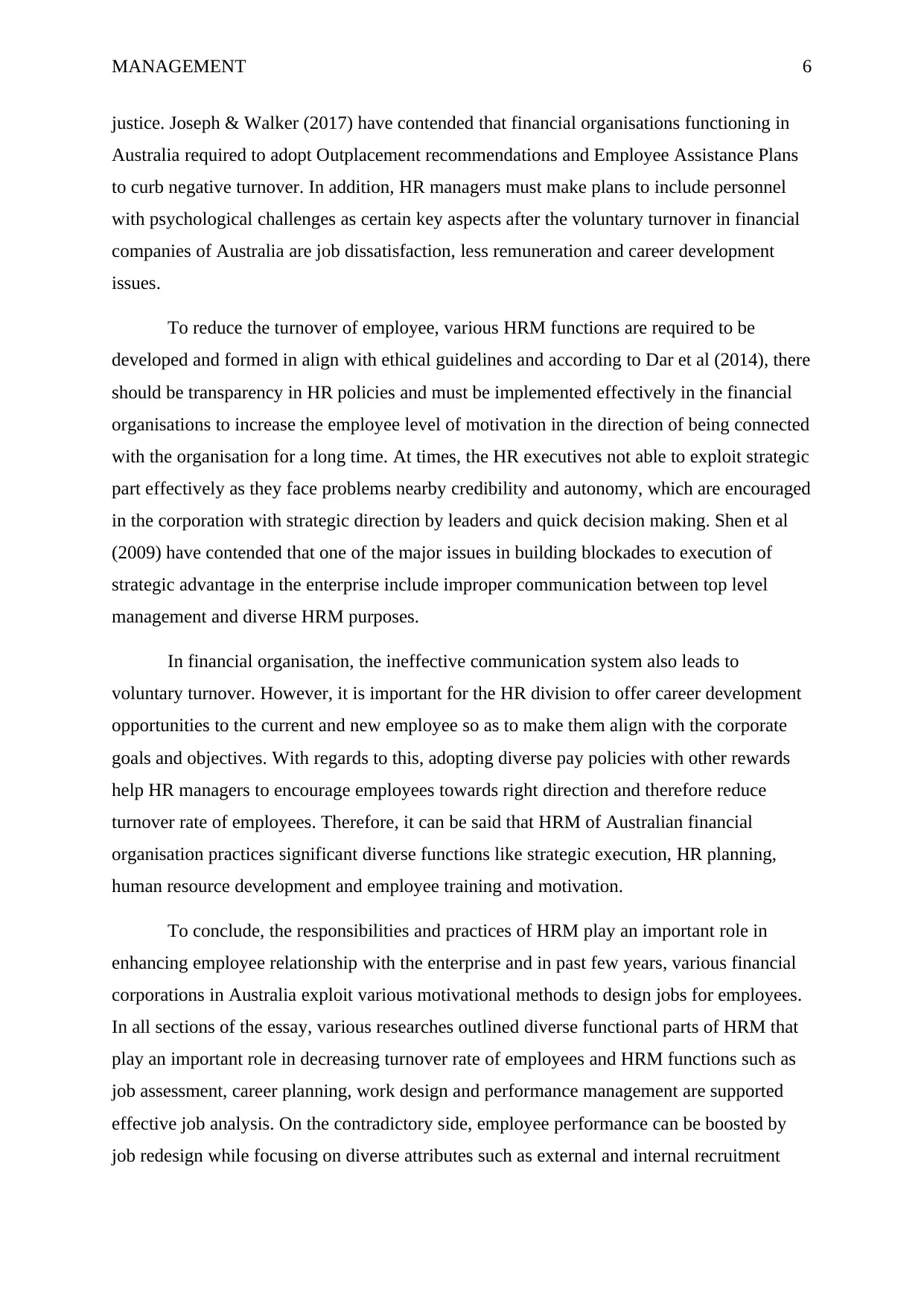
MANAGEMENT 6
justice. Joseph & Walker (2017) have contended that financial organisations functioning in
Australia required to adopt Outplacement recommendations and Employee Assistance Plans
to curb negative turnover. In addition, HR managers must make plans to include personnel
with psychological challenges as certain key aspects after the voluntary turnover in financial
companies of Australia are job dissatisfaction, less remuneration and career development
issues.
To reduce the turnover of employee, various HRM functions are required to be
developed and formed in align with ethical guidelines and according to Dar et al (2014), there
should be transparency in HR policies and must be implemented effectively in the financial
organisations to increase the employee level of motivation in the direction of being connected
with the organisation for a long time. At times, the HR executives not able to exploit strategic
part effectively as they face problems nearby credibility and autonomy, which are encouraged
in the corporation with strategic direction by leaders and quick decision making. Shen et al
(2009) have contended that one of the major issues in building blockades to execution of
strategic advantage in the enterprise include improper communication between top level
management and diverse HRM purposes.
In financial organisation, the ineffective communication system also leads to
voluntary turnover. However, it is important for the HR division to offer career development
opportunities to the current and new employee so as to make them align with the corporate
goals and objectives. With regards to this, adopting diverse pay policies with other rewards
help HR managers to encourage employees towards right direction and therefore reduce
turnover rate of employees. Therefore, it can be said that HRM of Australian financial
organisation practices significant diverse functions like strategic execution, HR planning,
human resource development and employee training and motivation.
To conclude, the responsibilities and practices of HRM play an important role in
enhancing employee relationship with the enterprise and in past few years, various financial
corporations in Australia exploit various motivational methods to design jobs for employees.
In all sections of the essay, various researches outlined diverse functional parts of HRM that
play an important role in decreasing turnover rate of employees and HRM functions such as
job assessment, career planning, work design and performance management are supported
effective job analysis. On the contradictory side, employee performance can be boosted by
job redesign while focusing on diverse attributes such as external and internal recruitment
justice. Joseph & Walker (2017) have contended that financial organisations functioning in
Australia required to adopt Outplacement recommendations and Employee Assistance Plans
to curb negative turnover. In addition, HR managers must make plans to include personnel
with psychological challenges as certain key aspects after the voluntary turnover in financial
companies of Australia are job dissatisfaction, less remuneration and career development
issues.
To reduce the turnover of employee, various HRM functions are required to be
developed and formed in align with ethical guidelines and according to Dar et al (2014), there
should be transparency in HR policies and must be implemented effectively in the financial
organisations to increase the employee level of motivation in the direction of being connected
with the organisation for a long time. At times, the HR executives not able to exploit strategic
part effectively as they face problems nearby credibility and autonomy, which are encouraged
in the corporation with strategic direction by leaders and quick decision making. Shen et al
(2009) have contended that one of the major issues in building blockades to execution of
strategic advantage in the enterprise include improper communication between top level
management and diverse HRM purposes.
In financial organisation, the ineffective communication system also leads to
voluntary turnover. However, it is important for the HR division to offer career development
opportunities to the current and new employee so as to make them align with the corporate
goals and objectives. With regards to this, adopting diverse pay policies with other rewards
help HR managers to encourage employees towards right direction and therefore reduce
turnover rate of employees. Therefore, it can be said that HRM of Australian financial
organisation practices significant diverse functions like strategic execution, HR planning,
human resource development and employee training and motivation.
To conclude, the responsibilities and practices of HRM play an important role in
enhancing employee relationship with the enterprise and in past few years, various financial
corporations in Australia exploit various motivational methods to design jobs for employees.
In all sections of the essay, various researches outlined diverse functional parts of HRM that
play an important role in decreasing turnover rate of employees and HRM functions such as
job assessment, career planning, work design and performance management are supported
effective job analysis. On the contradictory side, employee performance can be boosted by
job redesign while focusing on diverse attributes such as external and internal recruitment
Paraphrase This Document
Need a fresh take? Get an instant paraphrase of this document with our AI Paraphraser

MANAGEMENT 7
and employee motivation. In Australian financial corporations, it is significant for HR
managers to emphasis on hiring employee from diverse cultural environment for improving
the capabilities and skills of workforce. With regards to this, it is also important to focus on
significant SHRM strategies like formulation, evaluation, management and implementation to
reduce uncertainties in the business environment. This will bring down the various barriers
and enable organisation to connect its employees with the digital revolution. Hence, it will
make the industry stand out from the rest.
and employee motivation. In Australian financial corporations, it is significant for HR
managers to emphasis on hiring employee from diverse cultural environment for improving
the capabilities and skills of workforce. With regards to this, it is also important to focus on
significant SHRM strategies like formulation, evaluation, management and implementation to
reduce uncertainties in the business environment. This will bring down the various barriers
and enable organisation to connect its employees with the digital revolution. Hence, it will
make the industry stand out from the rest.

MANAGEMENT 8
References
Buciuniene, I., & Kazlauskaite, R. (2012). The linkage between HRM, CSR and performance
outcomes. Baltic Journal of Management, 7(1), 5-24.
Buller, P. F., & McEvoy, G. M. (2012). Strategy, human resource management and
performance: Sharpening line of sight. Human resource management review, 22(1),
43-56.
Canato, A., Ravasi, D., & Phillips, N. (2013). Coerced practice implementation in cases of
low cultural fit: Cultural change and practice adaptation during the implementation of
Six Sigma at 3M. Academy of Management Journal, 56(6), 1724-1753.
Dar, A. T., Bashir, M., Ghazanfar, F., & Abrar, M. (2014). Mediating role of employee
motivation in relationship to post-selection HRM practices and organizational
performance. International Review of Management and Marketing, 4(3), 224-238.
De Vos, A., De Hauw, S., & Van der Heijden, B. I. (2011). Competency development and
career success: The mediating role of employability. Journal of vocational
behavior, 79(2), 438-447.
Farndale, E., Scullion, H., & Sparrow, P. (2010). The role of the corporate HR function in
global talent management. Journal of world business, 45(2), 161-168.
fintech.treasury.gov.au. (2018). The strength of Australia’s financial sector. Retrieved from
https://fintech.treasury.gov.au/the-strength-of-australias-financial-sector/
Frerichs, F., Lindley, R., Aleksandrowicz, P., Baldauf, B., & Galloway, S. (2012). Active
ageing in organisations: a case study approach. International Journal of
Manpower, 33(6), 666-684.
Gibson-Graham, J. K. (2008). Diverse economies: performative practices forother
worlds'. Progress in Human Geography, 32(5), 613-632.
Gong, Y., Law, K. S., Chang, S., & Xin, K. R. (2009). Human resources management and
firm performance: The differential role of managerial affective and continuance
commitment. Journal of Applied Psychology, 94(1), 263.
References
Buciuniene, I., & Kazlauskaite, R. (2012). The linkage between HRM, CSR and performance
outcomes. Baltic Journal of Management, 7(1), 5-24.
Buller, P. F., & McEvoy, G. M. (2012). Strategy, human resource management and
performance: Sharpening line of sight. Human resource management review, 22(1),
43-56.
Canato, A., Ravasi, D., & Phillips, N. (2013). Coerced practice implementation in cases of
low cultural fit: Cultural change and practice adaptation during the implementation of
Six Sigma at 3M. Academy of Management Journal, 56(6), 1724-1753.
Dar, A. T., Bashir, M., Ghazanfar, F., & Abrar, M. (2014). Mediating role of employee
motivation in relationship to post-selection HRM practices and organizational
performance. International Review of Management and Marketing, 4(3), 224-238.
De Vos, A., De Hauw, S., & Van der Heijden, B. I. (2011). Competency development and
career success: The mediating role of employability. Journal of vocational
behavior, 79(2), 438-447.
Farndale, E., Scullion, H., & Sparrow, P. (2010). The role of the corporate HR function in
global talent management. Journal of world business, 45(2), 161-168.
fintech.treasury.gov.au. (2018). The strength of Australia’s financial sector. Retrieved from
https://fintech.treasury.gov.au/the-strength-of-australias-financial-sector/
Frerichs, F., Lindley, R., Aleksandrowicz, P., Baldauf, B., & Galloway, S. (2012). Active
ageing in organisations: a case study approach. International Journal of
Manpower, 33(6), 666-684.
Gibson-Graham, J. K. (2008). Diverse economies: performative practices forother
worlds'. Progress in Human Geography, 32(5), 613-632.
Gong, Y., Law, K. S., Chang, S., & Xin, K. R. (2009). Human resources management and
firm performance: The differential role of managerial affective and continuance
commitment. Journal of Applied Psychology, 94(1), 263.
⊘ This is a preview!⊘
Do you want full access?
Subscribe today to unlock all pages.

Trusted by 1+ million students worldwide
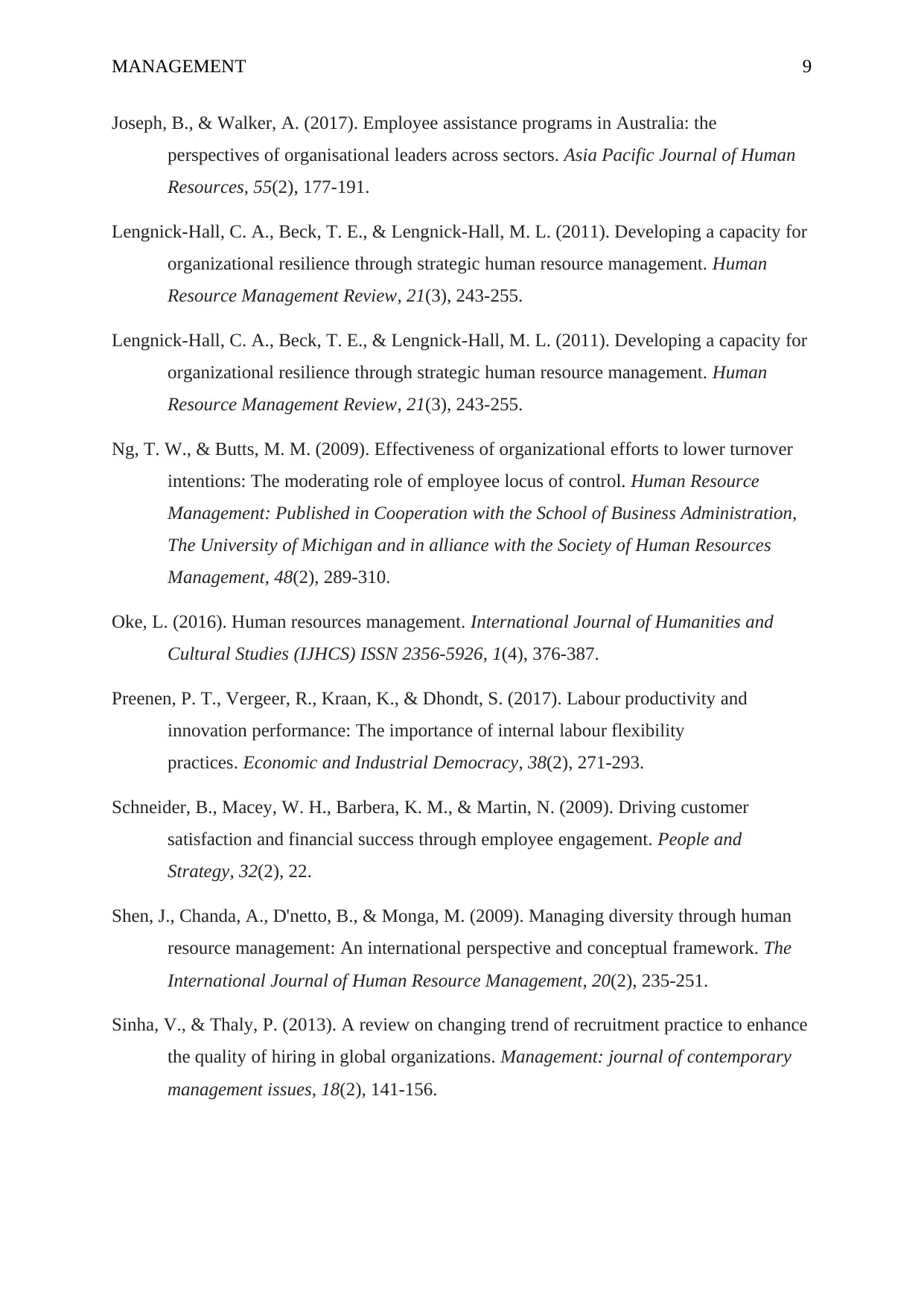
MANAGEMENT 9
Joseph, B., & Walker, A. (2017). Employee assistance programs in Australia: the
perspectives of organisational leaders across sectors. Asia Pacific Journal of Human
Resources, 55(2), 177-191.
Lengnick-Hall, C. A., Beck, T. E., & Lengnick-Hall, M. L. (2011). Developing a capacity for
organizational resilience through strategic human resource management. Human
Resource Management Review, 21(3), 243-255.
Lengnick-Hall, C. A., Beck, T. E., & Lengnick-Hall, M. L. (2011). Developing a capacity for
organizational resilience through strategic human resource management. Human
Resource Management Review, 21(3), 243-255.
Ng, T. W., & Butts, M. M. (2009). Effectiveness of organizational efforts to lower turnover
intentions: The moderating role of employee locus of control. Human Resource
Management: Published in Cooperation with the School of Business Administration,
The University of Michigan and in alliance with the Society of Human Resources
Management, 48(2), 289-310.
Oke, L. (2016). Human resources management. International Journal of Humanities and
Cultural Studies (IJHCS) ISSN 2356-5926, 1(4), 376-387.
Preenen, P. T., Vergeer, R., Kraan, K., & Dhondt, S. (2017). Labour productivity and
innovation performance: The importance of internal labour flexibility
practices. Economic and Industrial Democracy, 38(2), 271-293.
Schneider, B., Macey, W. H., Barbera, K. M., & Martin, N. (2009). Driving customer
satisfaction and financial success through employee engagement. People and
Strategy, 32(2), 22.
Shen, J., Chanda, A., D'netto, B., & Monga, M. (2009). Managing diversity through human
resource management: An international perspective and conceptual framework. The
International Journal of Human Resource Management, 20(2), 235-251.
Sinha, V., & Thaly, P. (2013). A review on changing trend of recruitment practice to enhance
the quality of hiring in global organizations. Management: journal of contemporary
management issues, 18(2), 141-156.
Joseph, B., & Walker, A. (2017). Employee assistance programs in Australia: the
perspectives of organisational leaders across sectors. Asia Pacific Journal of Human
Resources, 55(2), 177-191.
Lengnick-Hall, C. A., Beck, T. E., & Lengnick-Hall, M. L. (2011). Developing a capacity for
organizational resilience through strategic human resource management. Human
Resource Management Review, 21(3), 243-255.
Lengnick-Hall, C. A., Beck, T. E., & Lengnick-Hall, M. L. (2011). Developing a capacity for
organizational resilience through strategic human resource management. Human
Resource Management Review, 21(3), 243-255.
Ng, T. W., & Butts, M. M. (2009). Effectiveness of organizational efforts to lower turnover
intentions: The moderating role of employee locus of control. Human Resource
Management: Published in Cooperation with the School of Business Administration,
The University of Michigan and in alliance with the Society of Human Resources
Management, 48(2), 289-310.
Oke, L. (2016). Human resources management. International Journal of Humanities and
Cultural Studies (IJHCS) ISSN 2356-5926, 1(4), 376-387.
Preenen, P. T., Vergeer, R., Kraan, K., & Dhondt, S. (2017). Labour productivity and
innovation performance: The importance of internal labour flexibility
practices. Economic and Industrial Democracy, 38(2), 271-293.
Schneider, B., Macey, W. H., Barbera, K. M., & Martin, N. (2009). Driving customer
satisfaction and financial success through employee engagement. People and
Strategy, 32(2), 22.
Shen, J., Chanda, A., D'netto, B., & Monga, M. (2009). Managing diversity through human
resource management: An international perspective and conceptual framework. The
International Journal of Human Resource Management, 20(2), 235-251.
Sinha, V., & Thaly, P. (2013). A review on changing trend of recruitment practice to enhance
the quality of hiring in global organizations. Management: journal of contemporary
management issues, 18(2), 141-156.
Paraphrase This Document
Need a fresh take? Get an instant paraphrase of this document with our AI Paraphraser
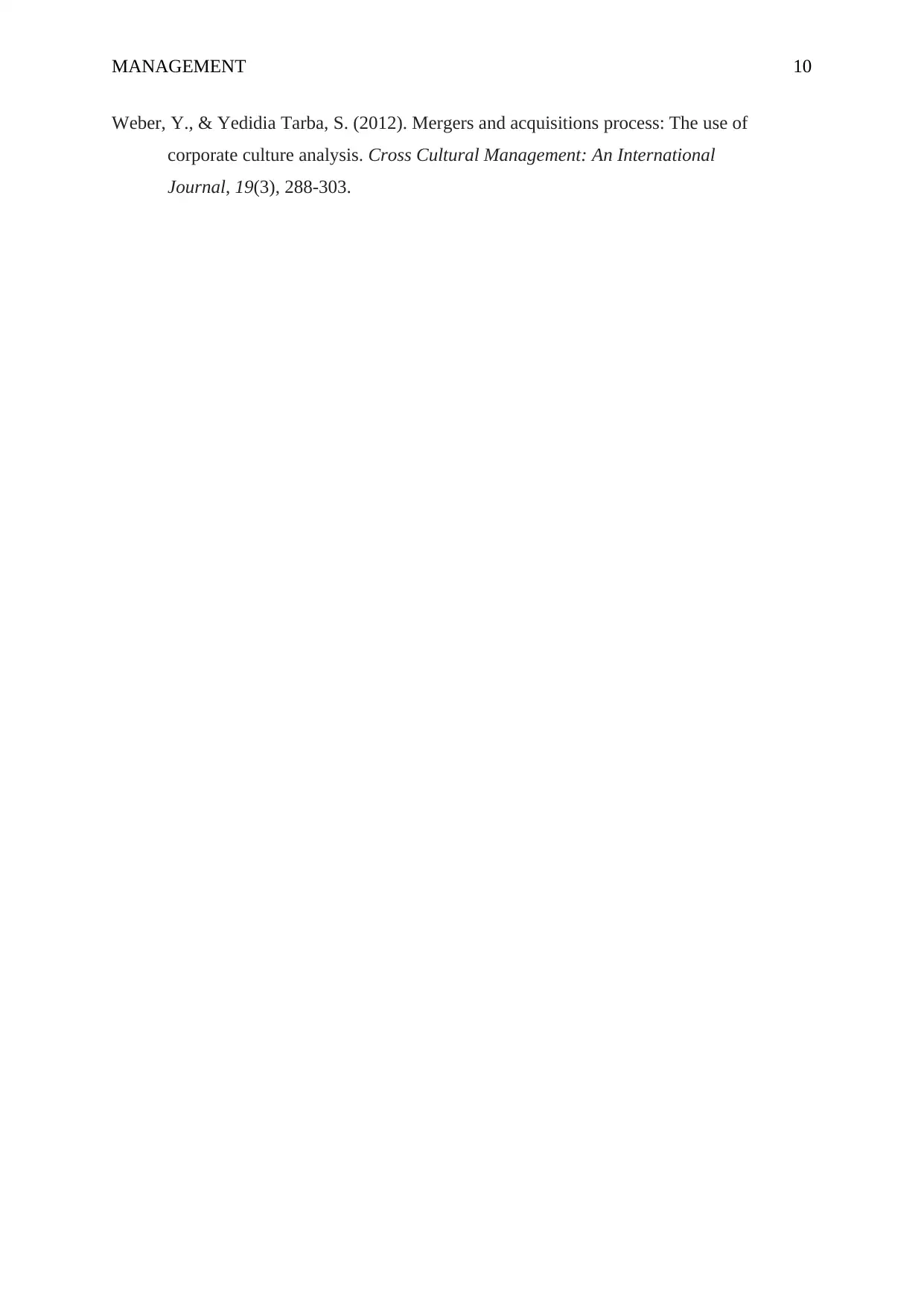
MANAGEMENT 10
Weber, Y., & Yedidia Tarba, S. (2012). Mergers and acquisitions process: The use of
corporate culture analysis. Cross Cultural Management: An International
Journal, 19(3), 288-303.
Weber, Y., & Yedidia Tarba, S. (2012). Mergers and acquisitions process: The use of
corporate culture analysis. Cross Cultural Management: An International
Journal, 19(3), 288-303.
1 out of 11
Related Documents
Your All-in-One AI-Powered Toolkit for Academic Success.
+13062052269
info@desklib.com
Available 24*7 on WhatsApp / Email
![[object Object]](/_next/static/media/star-bottom.7253800d.svg)
Unlock your academic potential
Copyright © 2020–2025 A2Z Services. All Rights Reserved. Developed and managed by ZUCOL.




